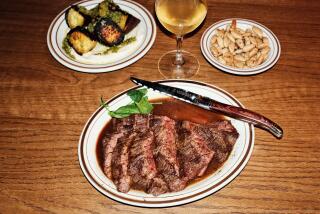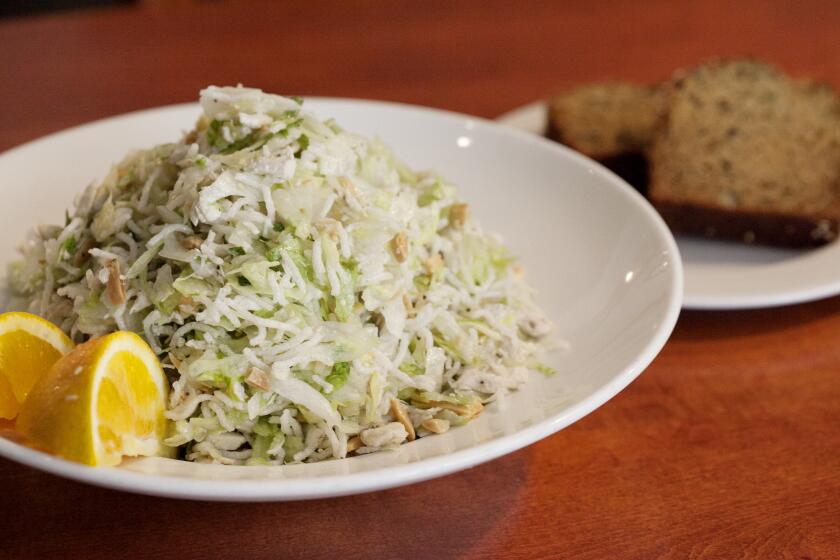Tofu’s elegant turn
- Share via
Imagine tofu. Not the bland sturdy cubes of the Birkenstock set, stir-fried with veggies. Picture instead a square pot of soy milk, cooking at the barest murmur. Eventually the milky surface will wrinkle and stiffen ever so slightly. It’s at that point that you take your chopsticks and pick the tofu skin up like a fine gauze handkerchief that’s -- oops -- fallen into a bucket of milk.
You can eat it from the bowl plain or with a splash of subtle shoyu sauce, some finely grated ginger and a sprinkling of toasted sesame seeds.
“Tofu skin” doesn’t begin to describe this ethereal delicacy from Kyoto. It’s nothing like the rubbery surface that forms when milk boils or when chocolate pudding cools. The texture is wonderfully delicate, closer to the finest pasta.
It’s called yuba, and at a new Beverly Hills restaurant, it stars in several kaiseki-style set menus. I’ve had yuba before, but I’ve never cooked it fresh, right at the table, as we’re doing tonight. We take turns plucking the freshly made tofu skin from the soy milk, watching the pot so we don’t miss the moment it’s first ready. Every set menu includes a communal dish. This one comes with the third, Ka Cho Fu Getsu Zen, “Flowers, Birds, Wind, Moon.”
The idea of an elegant tofu restaurant debuting in Beverly Hills is unusual, to say the least. And this is a large place -- 8,000 square feet. Could there possibly be that many tofu lovers out there? Umenohana’s Japanese owners seem to think there might be. With more than 70 branches in Japan, Umenohana is a highly successful chain. But will the concept fly here? I think it could, precisely because it is such a beautiful -- and quiet -- restaurant.
Designed by H. Hendy & Associates, the place has a lovely serenity and flow. In front, spiky grasses are planted in pale sand. Water sheets down a glass divider. There’s a large bar, and three separate dining rooms off a winding path lined with a lattice of fragrant inoki wood. In back is a tatami room. But the most arresting detail is the glassed-in yuba-making room; there you can watch cooks pluck the tofu skins from wooden vats of soy milk with bamboo rods and hang them up to dry.
I loved sitting in one of the booths, which enveloped six of us like a semiprivate room.
Before cooking our own yuba, we’ve already eaten it in a couple of other guises, including a spring roll of asparagus and crab leg rolled in it. We’ve had other kinds of tofu too, such as a fluffy tofu siumai dumpling that looks like a felted pompom. Inside the tender wrapping is a delicious chicken and shrimp stuffing shocked with ginger. It’s fabulous with a dot of Japanese mustard.
The meal began with a more rustic style of tofu, its texture reminiscent of fresh sheep’s milk ricotta. It came in a delicious salad of perky lettuces and Asian greens scattered with sesame seeds and toasted pine nuts and garnished with prosciutto and slices of fried lotus root.
Actually, against our waitress’ advice to order just one set menu for the table, we mixed it up. She cautioned us that it would take longer to serve the food if we ordered two different menus, but we did it anyway. She was right, but on a first visit, we wanted to try a lot of dishes.
Some of the courses repeat across the set menus, but others are quite different. In all, there are four at Umenohana, starting at $45 for the basic one called Umenohana Zen on up to $78 for the Ume Yu Zen, which includes half a lobster steamed with tofu in a bamboo leaf and a meat course of Kobe-style steak. But the latter menu is too much food. The Japanese owners may be overcompensating for America’s reputed prodigious appetites. Nobody will go home hungry after even the most basic menu.
One of my guests one night is a Japanese friend, Saiko, who is used to the famous tofu houses of Kyoto where yuba is a specialty and the presentation is very traditional. His eyes crinkle in amusement as the waitress hands me a martini glass with yuba topped with caviar. When he was growing up outside Tokyo, Saiko tells us, every city block had a tofu house. His wife, Sonoko, tells us about the tofu vendor who used to come by her house on a bicycle outfitted with a box that held the squares of tofu in water. Her grandmother would shoo her out of the house, holding a bowl filled with water into which the tofu man would transfer his wares. You have to eat it very fresh, like bufala mozzarella.
“I tried to make tofu one time,” she tells us, laughing. “What a mess! It sounds easy, but I ended up with soy milk all over myself, the whole kitchen dirty, and one little square of tofu in the end.”
When I called to invite these friends to Umenohana, Sonoko accepted right away, saying, “I love tofu! I could make an entire meal of tofu!” You will, I said.
After trying all four of the set menus, I sometimes prefer ordering a la carte. The only problem is that some of the best dishes are not on the small a la carte menu. My sense is that in trying to make tofu more appealing to Americans, the restaurant is beefing up the menus with nontraditional dishes, such as Kobe steak, or gimmicky presentations like the miniature tansu with chilled porcelain “drawers” filled with various tidbits. But actually, the classic preparations appeal most, because they’re hard to find in this country and the quality is impeccable. So while I enjoy the chilled yuba topped with caviar, I prefer the fresh yuba served in a wooden bucket with soy milk and swatches of spinach. My Japanese friends would have preferred something even more simple: yuba laid on the plate like sashimi with a dab of wasabi.
For me, the most spectacular dish is the silken tofu, which we cooked at our table. The waitress sets a square metal pot with a pine lid on the heating element in the middle of the table. After 20 minutes or so, with a special curved bamboo ladle, she scoops up the fragile tofu. The texture is something like an ethereal flan. You can have it with mabo, a spicy pork sauce, or with a shiitake and vegetable sauce swirled with green onion oil. No contest, take the mabo. The combination -- fiery pork sauce and tofu that’s so delicate it threatens to dissolve away at any moment -- is heavenly. I would come back just for this.
Every menu also includes chawan-mushi, a savory egg custard studded with shrimp, water chestnut and eryngii mushrooms. You can order it in three styles -- traditional, creamy or spicy. Traditional is the way to go: It’s understated and elegant. The creamy style is oddly unappealing; the spicy version overwhelms the delicacy of the custard.
Some of the communal dishes are terrific too. I particularly liked tofu hot pot from the basic menu. It’s blocks of tofu blanketed with yuba and topped with namafu (wheat gluten) cut in flower shapes. The waiter pours in a special water, it cooks, and you eat it garnished to taste with toasted sesame seeds, freshly grated (and very sharp) ginger and Warishoyu. Namafu appeared again a couple of courses later threaded on skewers, dipped in sweet miso and grilled. It’s chewy and delicious, much like mochi, or pounded rice, in texture.
The sushi that comes toward the end of the meal is unimpressive, like pretty petits fours without much taste or interest. It’s not bad, it just doesn’t have the pristine freshness of the best sushi. And the chef’s special sushi roll of yuba, cream cheese and raisins was completely unappealing.
The staff, though, is utterly charming. When I called one night to say I would be late, the Japanese hostess wished us a safe drive and told us they were waiting for us. When we finally arrived, she welcomed us gracefully and commented, “Such a traffic!” Waiters all underwent six weeks of training before the restaurant opened; they navigate the Japanese words on the menu with ease and can explain the dishes and how they’re prepared. Though dishes can sometimes be slow coming from the kitchen, the service in the dining room is as good as it gets in L.A.
We felt so cozy sitting in our high-sided booth that we ended up wandering out well after 11 p.m. But not before my friend Missy came back from the ladies’ room wearing a goofy grin. “You have to go,” she urged me. So I did and found they’d installed fancy Toto toilets that wash and dry you with the touch of a button. Such a pampering!
*
Umenohana
Rating: **
Location: 443 N. Canon Drive, Beverly Hills; (310) 860-9236
Ambience: Serene and gracious Japanese restaurant specializing in tofu. Three separate dining rooms open off a winding pathway framed in pale inoki wood. Order from four set menus, all of which involve cooking a main dish at the table, or from the small a la carte menu.
Service: Knowledgeable and helpful; sometimes, though, the food is slow coming from the kitchen.
Price: Set tofu dinners, $45 to $100; set lunch menus, $24 to $36; a la carte items, $5 to $28
Best dishes: Tofu salad, yudofu (warm tofu in a wooden bucket), tofu siumai dumpling, tofu hot pot, Mineoka tofu, tofu with spicy pork sauce, fresh yuba cooked at your table
Wine list: Small and fairly eclectic for a Japanese restaurant, but needs more selections that work with the food. Corkage, $25.
Best table: One of the tall, high-sided booths in the main dining room
Special features: Toto toilets that wash and dry in the restrooms. Also tatami dining room at the back.
Details: Open daily for lunch from 11:30 a.m. to 2 p.m. and for dinner from 5:30 to 10 p.m. Full bar. Valet parking, $5 for 2 hours, $1.50 per additional hour.
Rating is based on food, service and ambience, with price taken into account in relation to quality. ****: Outstanding on every level. ***: Excellent. **: Very good. *: Good. No star: Poor to satisfactory.
More to Read
Eat your way across L.A.
Get our weekly Tasting Notes newsletter for reviews, news and more.
You may occasionally receive promotional content from the Los Angeles Times.










